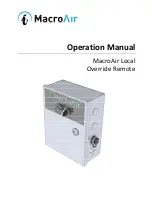
Operating instructions
R3G355-AY43-21
Translation of the original operating instructions
4.6 Checking the connections
;
Make sure that the power is off (all phases).
;
Secure it from being switched on again.
;
Check the correct fit of the connection lines.
;
Screw the terminal box cover closed again. Terminal box tightening
torque, see chapter 3.1 Product drawing.
;
Route the connecting cables in the terminal box so that the terminal
box cover closes without resistance.
;
Use all plug screws (the entire number). In doing so, insert the
screws manually to avoid damage to the thread.
;
Make sure that the terminal box is correctly closed and sealed and
that all screws and screwed cable glands are properly tightened.
4.7 Switch on device
The device is not to be switched on until it has been installed properly
and in accordance with its intended use, including the required protective
devices and professional electrical connection. This also applies to
devices which have already been equipped with plugs and terminals or
similar connectors by the customer.
WARNING
Hot motor housing
Fire hazard
→ Ensure that no combustible or flammable materials are
located close to the fan.
;
Inspect the device for visible external damage and the proper function
of the protective features before switching it on.
;
Check the air flow paths of the fan for foreign objects and remove any
that are found.
;
Apply the nominal voltage to the voltage supply.
;
Start the device by changing the input signal.
NOTE
Damage to device by vibrations
Bearing damage, reduced service life
→ The fan must operate free of vibrations throughout its speed
control range.
→ Strong vibrations can result from improper handling,
imbalance resulting from damage during transport, or
component-induced or structural resonances.
→ When putting the fan into service, determine the speed
ranges with excessive vibration levels and also any
resonance frequencies that may be present.
→ When regulating the speed, pass through resonance
ranges as quickly as possible or find another remedy.
→ Operation at excessive vibration levels can lead to
premature failure.
→ The maximum vibration severity may not exceed 3.5 mm/s
and should be checked every 6 months. #It must be
measured at least in and perpendicular to the axial direction
at the place where the motor is attached to the motor support
plate. #Vibration measurements in all three axes are
recommended and should be performed across the entire
speed range in order to gain a complete understanding of all
vibrations present in an application; see chapter 6.
Maintenance, malfunctions, possible causes and remedies.
4.8 Switching off the device
Switching off the device during operation:
;
Switch off the device via the control input.
;
Do not switch the motor (e.g. in cyclic operation) on and off via power
supply.
Switching off the device for maintenance work:
;
Switch off the device via the control input.
;
Do not switch the motor (e.g. in cyclic operation) on and off via power
supply.
;
Disconnect the device from the supply voltage.
;
When disconnecting, be sure to disconnect the earth wire connection
last.
5. INTEGRATED PROTECTIVE FUNCTIONS
The integrated protective functions cause the motor to switch off
automatically in case of faults described in the table.
Malfunctions
Description / Function of
safety feature
Rotor position detection error
An automatic restart occurs.
Locked rotor
;
After the blockage is
removed, the motor restarts
automatically.
Line under-voltage (mains input
voltage outside of permitted
nominal voltage)
;
If the mains supply voltage
returns to permitted values, the
motor restarts automatically.
Item no. 51028-5-9970 · ENG · Revision 212555 · Release 2020-04-29 · Page 11 / 14
ebm-papst Mulfingen GmbH & Co. KG · Bachmühle 2 · D-74673 Mulfingen · Phone +49 (0) 7938 81-0 · Fax +49 (0) 7938 81-110 · [email protected] · www.ebmpapst.com
































